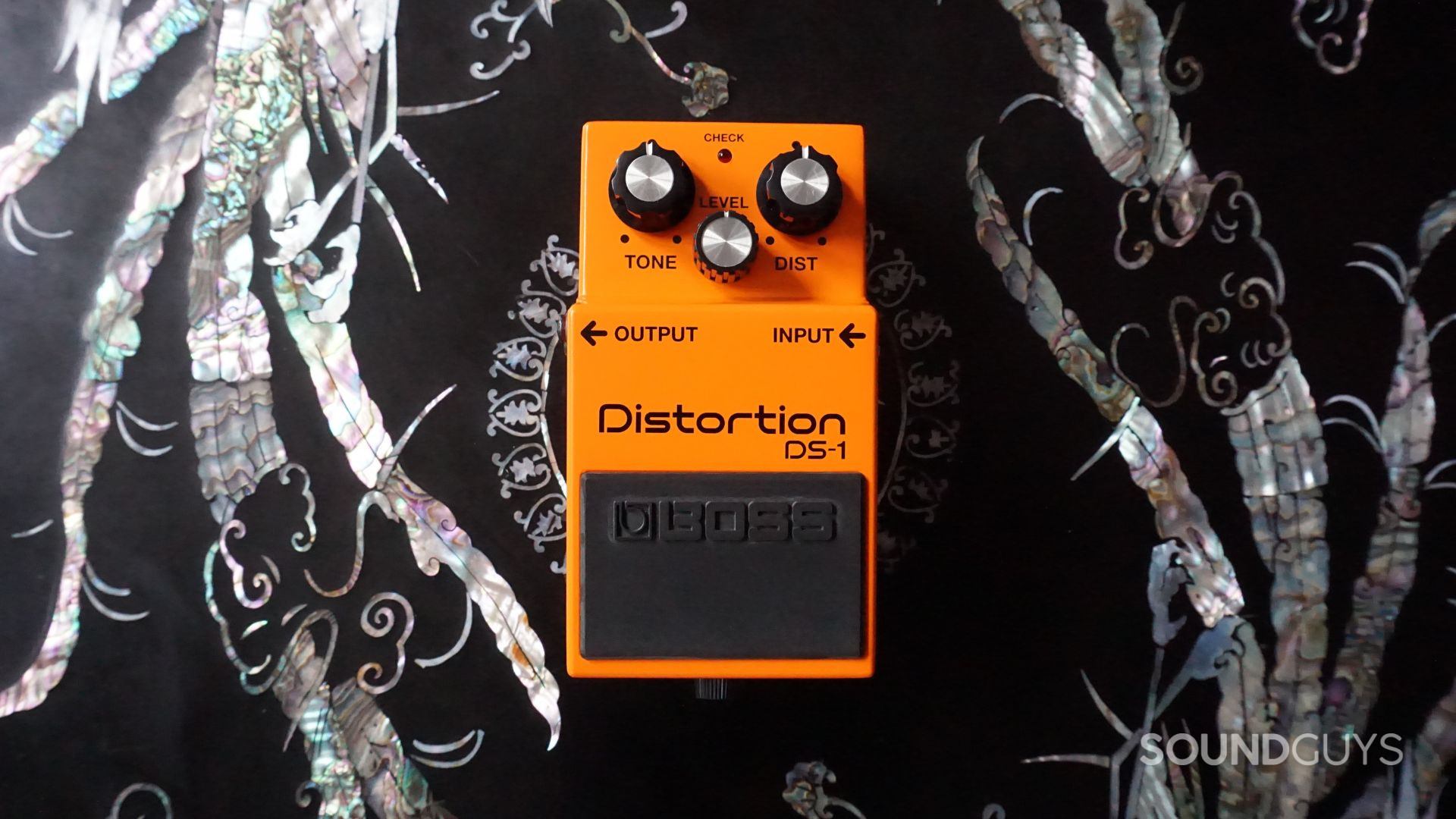All products featured are independently chosen by us. However, SoundGuys may receive a commission on orders placed through its retail links. See our ethics statement.


BOSS DS-1
Since 1973, BOSS has established itself as a world-leading music electronics company. In particular, the company produces some of the most prolific guitar amplifiers, compact effects processors, and digital recorders that money can buy. In 1978, one year after the company unveiled its iconic compact series, the BOSS DS-1 analog distortion pedal was born. Since its inception, the pedal has influenced generations of music and remains among the most desirable sounds on any guitarist’s pedalboard. But with intense competition from low-cost modern brands, can this trusted oldie keep pace with the newbies? Find out more in SoundGuys’ BOSS DS-1 review.
BOSS DS-1 review: At a glance
- What is it? The BOSS DS-1 is a compact analog distortion pedal for the electric guitar.
- What is the price? The BOSS DS-1 costs $62.99.
- Where can you buy it? The BOSS DS-1 is readily available worldwide from Amazon and dedicated dealerships, including Premier, Roland, and more.
- How did we test it? I tested the BOSS DS-1 for six days with a Fender American Deluxe Telecaster guitar and Marshall Valvestate 2000 AVT100 amplifier. SoundGuys purchased the review unit.
- Is it worth it? The BOSS DS-1 is an excellent analog distortion pedal for beginners and professionals. It delivers an iconic hard-edged attack with smooth sustain and is highly versatile. It also comes packaged in a robust and lightweight enclosure and is easily visible on a pedalboard thanks to its bright metallic orange color. While it is less qualified for high-gain, modern metal sounds, it delivers distortion when needed.
What I like about the BOSS DS-1
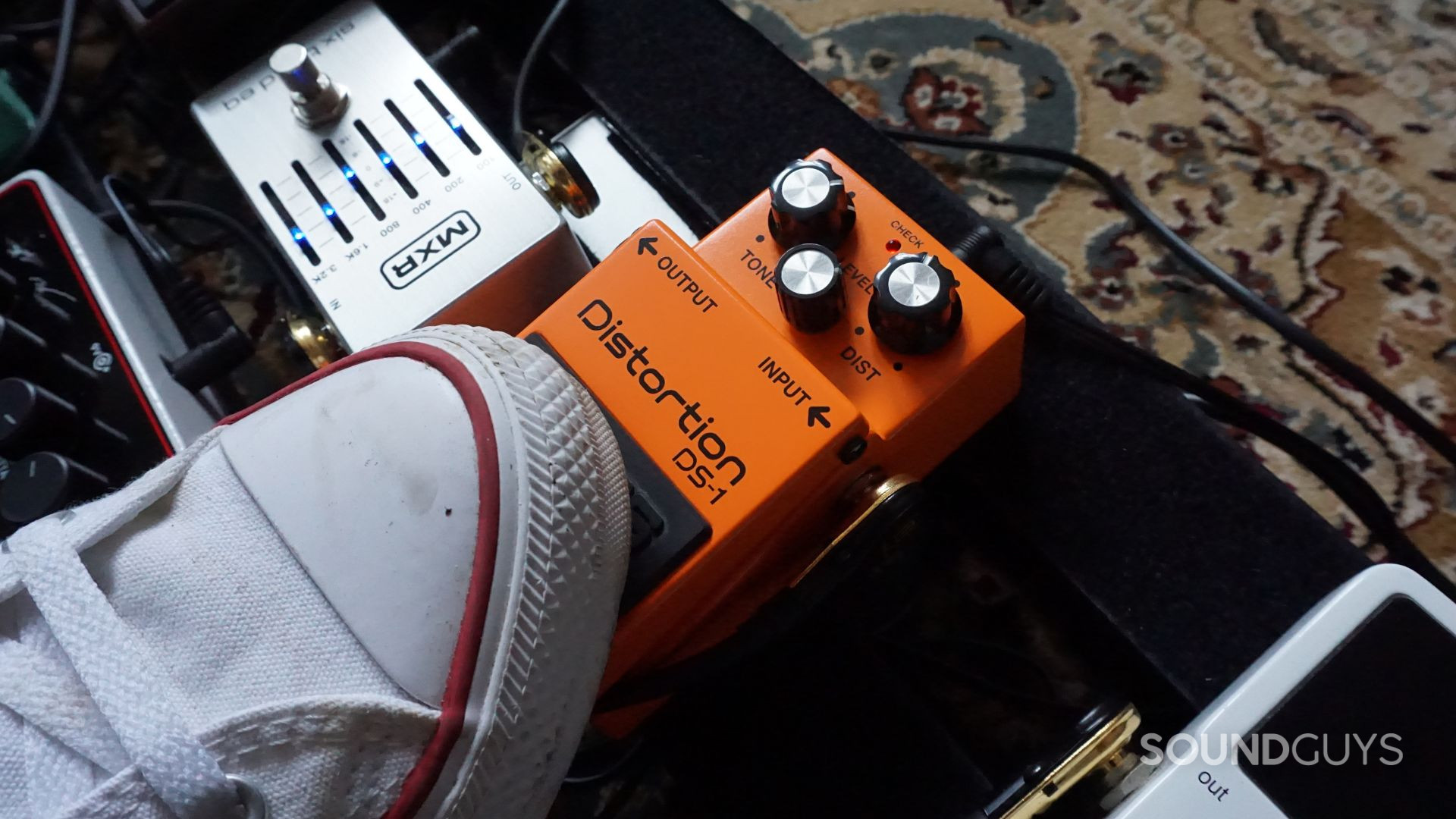
BOSS is revered for designing effects pedals that are virtually indestructible, and the DS-1 is no different. The pedal has a thick all-metal cast enclosure that feels extremely robust underfoot. Unlike most competing effects pedals, the BOSS DS-1 houses its stomp switch beneath a 65 x 78 mm cover. This features an encapsulated rubberized pad that increases grip between the pedal and sole of your foot. It also protects the battery compartment from accidental drops and spillages. The DS-1 feels extremely premium when pitted against other pedals that house exposed stomp switches and lighter builds. That’s not to say the DS-1 is heavy — the pedal sports a compact 73 x 129 x 59 mm form factor and weighs 360g. The BOSS DS-1 is an attractive and bright metallic orange color that is easy to see in darker environments. This is handy for quickly locating the pedal in low-lit music venues.
Like most guitar effects pedals, the DS-1 supports 1/4″ TS jack input and output. Similarly, a 9-volt AC adaptor or a 9-volt battery can power the pedal. BOSS recommends purchasing one of its PSA-series power supplies ($29.99 at Amazon,) but any 9-volt center negative power supply should work. This is handy for hooking the pedal up to a dedicated pedalboard power supply like the T-Rex Fuel Tank Junior ($152 at Amazon) and MXR Iso-Brick ($169.99 at Amazon.) Thoughtfully, BOSS ships the pedal with a carbon-zinc battery pre-installed. When used with batteries, BOSS states that the DS-1 should last approximately 50 hours with carbon-zinc batteries and 80 hours with alkaline batteries. While these estimates will vary depending on the individual conditions of use, the pedal should last plenty long enough for several practice sessions and gigs. The pedal has a useful red LED check indicator to alert you when the battery is running low.
The BOSS DS-1 has enjoyed over 45 years of success and remains one of the industry's leading distortion pedals
The BOSS DS-1 delivers a versatile spectrum of sound thanks to its pioneering dual-stage circuit that incorporates both transistor and op-amp gain stages. The pedal’s three-knob interface is intuitive and adjusts tone, level, and distortion. Dialing the tone knob clockwise increases highs and decreases lows, while turning counter-clockwise has the opposite effect. This makes it easy to dial in everything from tight-cutting rhythmic sounds to smooth and low-bodied lead tones. The level knob is simple and can be adjusted to match the volume of distortion against your bypassed clean tone. The aptly-named distortion knob controls the intensity of distortion.
The pedal works great as a booster at low levels, while maxing out the dial delivers high-octane gain for heavy rock riffs. The sound quality is excellent, and turning down your guitar’s volume dial cleans up the tone without introducing muddiness. The pedal’s tone knob is especially effective at maintaining low-end definition when used as a booster with vintage amps.
What I don’t like about the BOSS DS-1
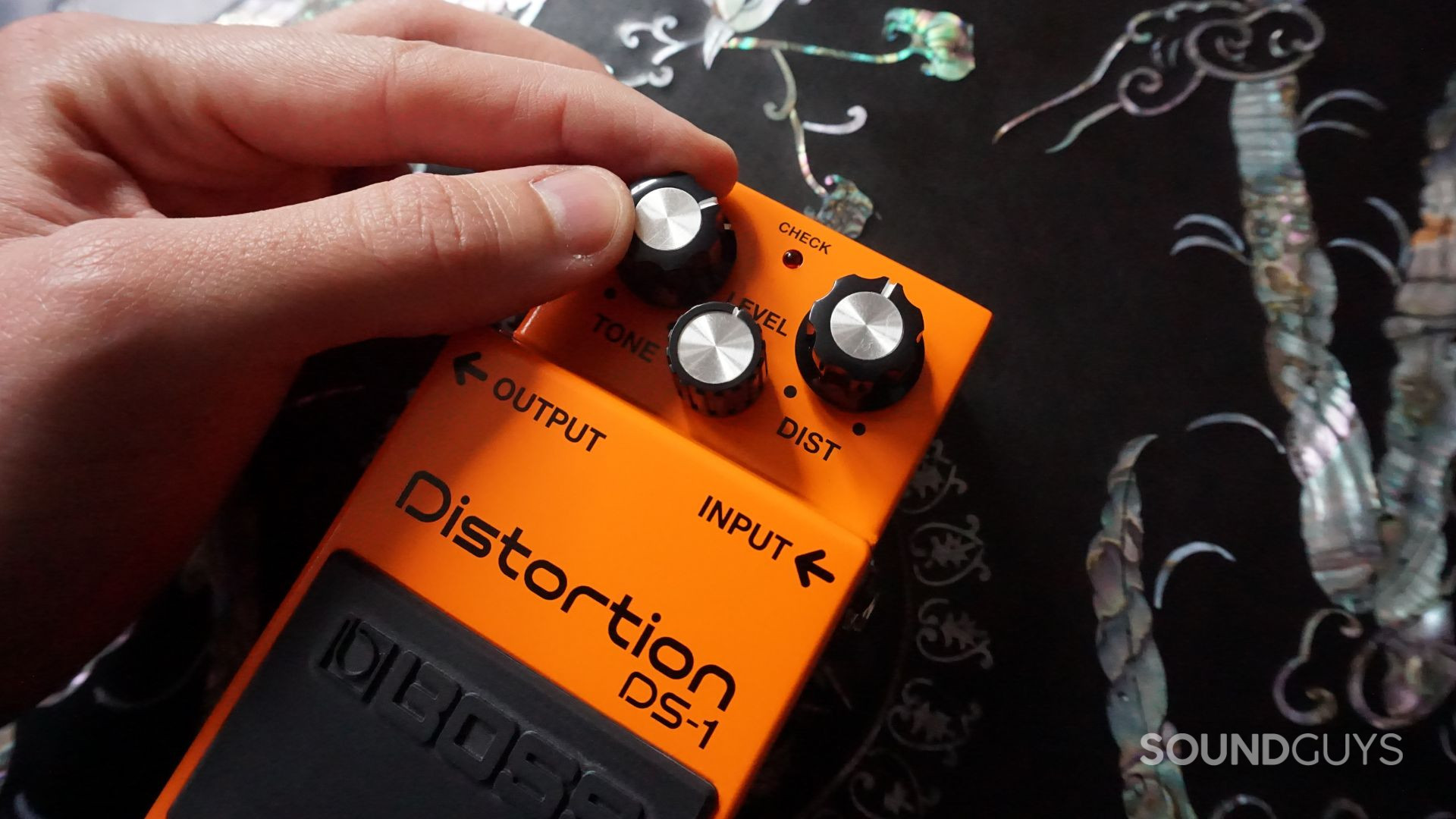
While it is hard to critique a pedal that has gained critical acclaim for over 45 years, there are some niggles worth addressing. For example, the DS-1 does not ship with a 9-volt power supply. Instead, BOSS recommends you purchase one of its PSA-series power supplies. While certainly not a deal breaker, it does add an extra layer of inconvenience to the user experience.
The BOSS DS-1 also has comparatively limited functionality when pitted against other distortion pedals on the market. For example, the Fender Pugilist Distortion ($115.23 at Amazon) has two separate distortion channels that can be blended or stacked in series. The pedal also has a bass boost switch for filling out low frequencies when playing through a clean amplifier. Another rival, the MXR Super Badass Distortion ($129.99 at Amazon,) offers a three-band EQ to fine-tune your sound and shape the output to your preferences. Compared to these pedals, the BOSS DS-1 feels like a somewhat more barebones affair.
The BOSS DS-1 owns a relatively limited feature set compared to some of its similarly-priced competitors
Like all consumer electronics products, effects pedals have gotten smaller over time. From the sizeable 1969 Big Muff Pi V1 to the tiny Hotone KRUSH ($59.99 at Amazon,) guitarists have more space than ever on their pedalboards. However, while the BOSS DS-1 was considered compact in 1978, much smaller pedals are now available for space-conscious guitarists. For example, the MOOER Ultra Drive MKII ($149.96 at Amazon) is an excellent compact distortion pedal measuring 42 x 94 x 52 mm. However, the DS-1’s robust form factor ensures the pedal can withstand tours and repeated use. Nevertheless, repackaging the infamous DS-1 circuit board into a smaller or more stylish casing would reinvigorate the company’s product range.
The BOSS DS-1 can handle almost any distorted music style you throw at it. However, it plays less nicely than some of its rivals when trying to reproduce high-gain drive. The pedal is not a specialty metal pedal; it stops short of super modern metal sounds. Other pedals, like the Keeley Filaments High Gain Distortion ($189 at Amazon,) replicate high-gain tube amps more accurately. In particular, the Filaments High Gain Distortion layers three gain stages and provides seven ways to EQ the tone. It is also substantially louder than the DS-1, given it can run with 18 volts. Notably, the DS-1 has a lower output volume than other 9-volt distortion pedals on the market.
How does the BOSS DS-1 sound?
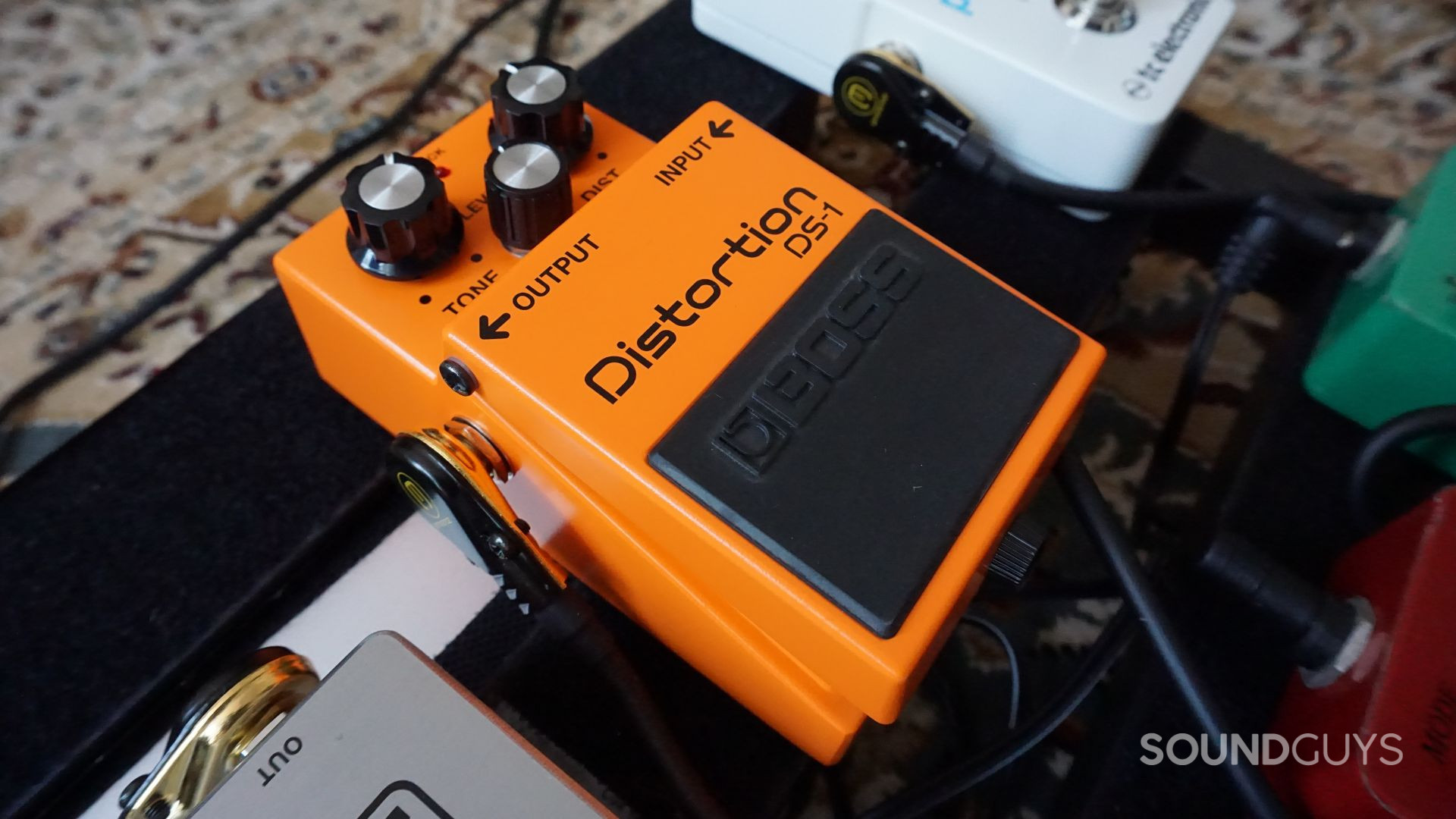
Below are three examples initially played bypassed and then with the distortion knob set to three extremes. The first has the distortion dial turned fully counter-clockwise. The second has the distortion knob set to midnight, and the third has the distortion dial turned fully clockwise. I recorded each sample with a Fender American Deluxe Telecaster guitar directly into my DAW through a Focusrite Scarlette 6i6 ($449.99 at Amazon) interface using 1/4″ TS cables.
BOSS DS-1 clean vs low distortion sample
BOSS DS-1 clean vs. middle distortion sample
BOSS DS-1 clean vs high distortion sample
To showcase each sample fairly, I set the BOSS DS-1 tone knob to midnight and left my guitar on the bridge pickup.
BOSS DS-1 specs
| Boss DS-1 | |
|---|---|
Size | 73 x 129 x 59 mm |
Weight | 360g |
Connection | Wired |
Controls | Knobs, stomp switch |
Audio inputs | 1/4" TS jack |
Audio outputs | 1/4" TS jack |
Wireless audio connection | N/A |
Power connector | 9-volt AC adaptor, 9-volt alkaline battery, 9-volt carbon-zinc battery |
Price | $62.99 |
Should you buy the BOSS DS-1?
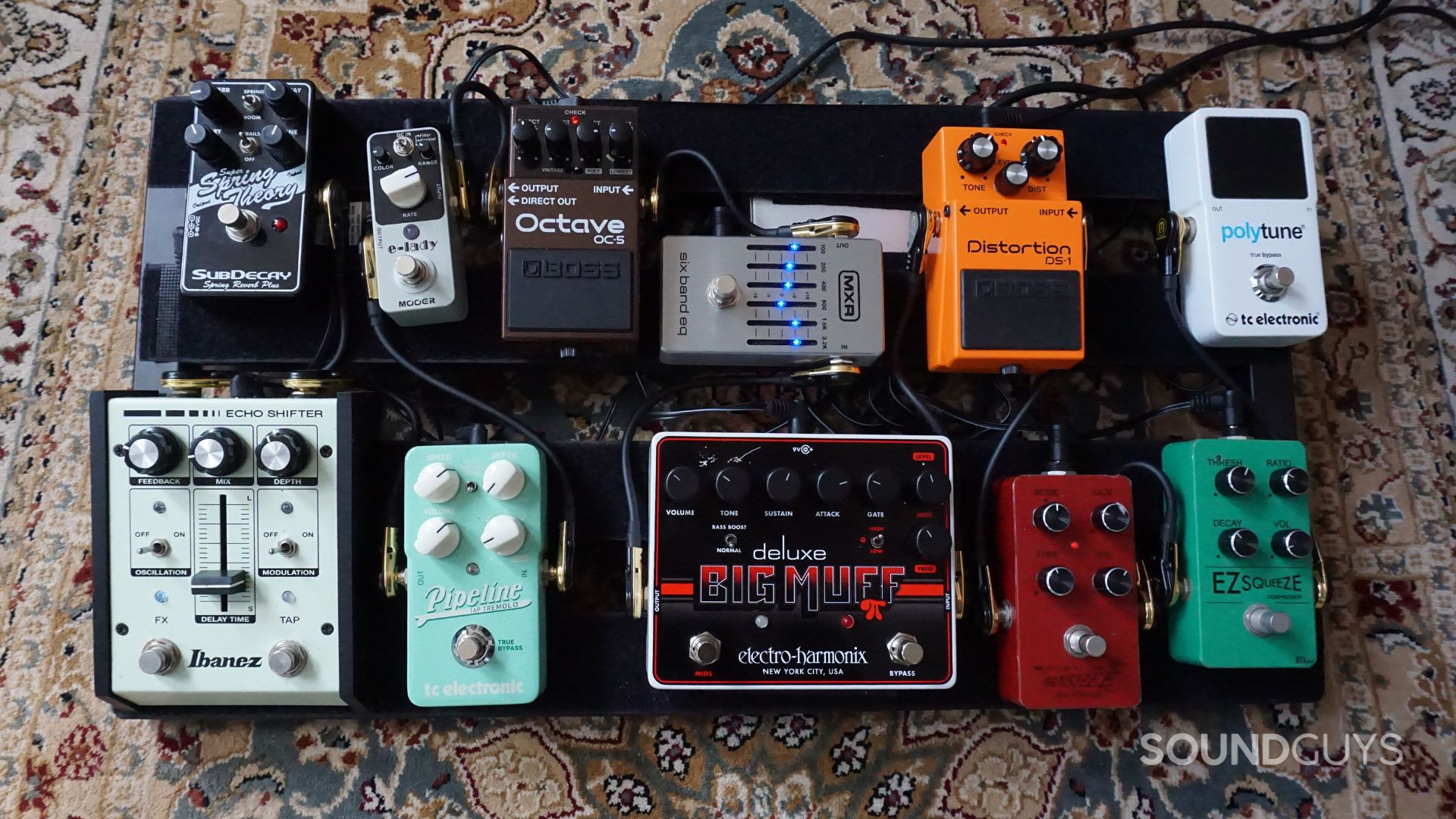
With the BOSS DS-1 ($62.99 at Amazon) beginners have plenty to play with to find their favorite tone, while more advanced players can easily integrate the pedal into their board. The three knobs are intuitive, and the DS-1 delivers a wide range of adjustments. However, some similarly priced distortion pedals offer more versatility. For example, the Wampler Sovereign Distortion ($187.97 at Amazon) boasts a mid-contour knob for shaping midrange frequencies. It also has a bright/even switch for toggling between a mids-heavy sound and a top-heavy treble. Those wanting a dirtier tone can use the gain/boost switch to flit between more responsive overdriven tones and gritty gain.
Nevertheless, the BOSS DS-1 is a compelling choice for experimenting with guitar effects and getting acquainted with distortion. The tone dial is handy for shaping high and low-end frequencies, and the distortion knob brings an evenly increasing level of intensity. Guitarists can use the level dial to achieve a balanced volume between the clean bypassed signal and the pedal’s distortion. The build quality feels robust, and BOSS’s five-year warranty is a nice bonus.
The BOSS DS-1 offers excellent value for money
While the BOSS DS-1 remains a relatively compact design, there are smaller distortion pedals that also pack a punch. For example, the Mooer Black Secret ($40.99 at Amazon) has a 45 x 108 x 57 mm form factor and is equipped with both Vintage and Turbo modes. The former profits a warmer vintage distortion sound, while the latter delivers a gnarlier output that is twice the maximum output volume of the Vintage setting. However, a significant caveat of mini effects pedals is that they are often too small to house 9-volt batteries.
Those wanting a classic-sounding distortion pedal outside the BOSS ecosystem should consider the Pro Co Lil’ RAT ($89.99 at Amazon.) The smaller twin of the famous Proco Rat, this pedal excels at rock rhythm tones and soaring gain lead lines. Like the BOSS DS-1, the ProCo Lil’ Rat performs excellently as a booster for added kick when soloing. It also features a robust all-steel enclosure measuring 64 x 50 x 79 mm and weighing just 270g. However, like other mini effects pedals, the ProCo Lil’ Rat has no battery compartment. Instead, guitarists must power the pedal with a 9-volt AC adapter.


BOSS DS-1 review: FAQs
While the BOSS DS-1 can handle virtually any type of distorted music you throw at it, it is not a specialty metal pedal. Other pedals, like the Keeley Electronics Filaments, replicate ultra high-gain tube amps more accurately.
Like the majority of guitar pedals on the market, the BOSS DS-1 requires 9-volt center-pin negative.
The BOSS DS-1 requires either a 9-volt AC power adapter or 9-volt alkaline or carbon-zinc batteries to work.
The BOSS DS-1 works perfectly well with single coil pickups. However, as is the case with all effects pedals, it is worth taking the time to experiment with different guitars, amplifiers, and pickups before purchasing.
The BOSS DS-1 is an analog pedal with a two-stage circuit that incorporates both transistor and op-amp gain stages.
